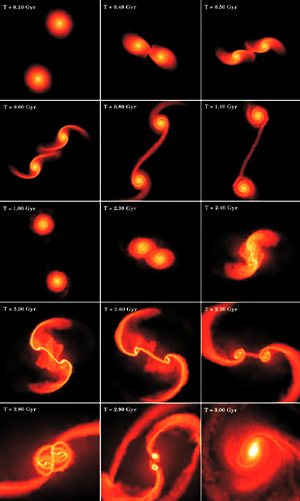Simulating cosmic collisions prepares astronomers to detect gravitational waves
By Steve KoppesNews Office
 The gaseous disks of two galaxies collide in this series of images produced in a supercomputer simulation. Approximately three billion years after the collision begins, the two supermassive black holes at the center of the galaxies merge. Such mergers produce strong gravitational waves, which scientists hope to detect with the proposed Laser Interferometer Space Antenna. An international team of scientists led by Stelios Kazantzidis of the Kavli Institute for Cosmological Physics performed the simulations to elucidate the processes that lead to the merger of supermassive black holes and the production of gravitational waves. | |
A wispy collection of atoms and molecules fuels the vast cosmic maelstroms produced by colliding galaxies and merging supermassive black holes, according to some of the most extensive supercomputer simulations ever conducted.
“We found that gas is essential in driving the co-evolution of galaxies and supermassive black holes,” said Stelios Kazantzidis, a Fellow in the University’s Kavli Institute for Cosmological Physics. He and his collaborators published their results in the April 2005 issue of The Astrophysical Journal and in February on astro-ph, an online repository of astronomical research papers. They also are preparing another study.
The collaboration includes Lucio Mayer from the Swiss Federal Institute of Technology, Zurich; Monica Colpi, University Milano-Bicocca; Piero Madau, University of California, Santa Cruz; Thomas Quinn, University of Washington; and James Wadsley, McMaster University.
“This type of work became possible only recently thanks to the increased power of supercomputers,” Mayer said. Improvements in the development of computer code that describes the relevant physics also helped, he said.
“The combination of both code and hardware improvement makes it possible to simulate in a few months time what had required several years of computation time only four to five years ago.”
The findings are good news for NASA’s proposed LISA (Laser Interferometer Space Antenna) mission. Scheduled for launch in 2015, LISA’s primary objective is to search the early universe for gravitational waves. These waves, never directly detected, are predicted in Einstein’s theory of general relativity.
“At very early times in the universe there was a lot of gas in the galaxies, and as the Universe evolves, the gas is consumed by star formation,” Kazantzidis said. And large amounts of gas mean more colliding galaxies and merging supermassive black holes. This is important because LISA is detecting gravitational waves. And the strongest source of gravitational waves in the universe will be from colliding supermassive black holes,” he said.
Many galaxies, including the Milky Way galaxy that contains the sun, harbor supermassive black holes at their center. These black holes are so gravitationally powerful that nothing, including light, can escape their grasp.
Today the Milky Way moves quietly through space by itself, but one day it will collide with its nearest neighbor, the Andromeda galaxy.
Nevertheless, the Milky Way served as a handy model for the galaxies in the merging supermassive black hole simulations. Kazantzidis’s team simulated the collisions of 25 galaxy pairs to identify the key factors leading to supermassive black hole mergers.
For these mergers to occur, the host galaxies must merge first. Two gas-poor galaxies may or may not merge, depending on the structure of the galaxies. But whenever gas-rich galaxies collide in the simulations, supermassive black-hole mergers typically followed.
“The more supermassive black holes that you predict will merge, the larger number of sources that LISA will be able to detect,” Kazantzidis said.
As two galaxies begin to collide, the gas they contain loses energy and migrates to their respective cores. This process increases the density and stability of the galactic cores. When these cores merge, the supermassive black holes they host also merge. When these cores become disrupted, their supermassive black holes fail to merge.
Each simulation conducted by Kazantzidis consumed approximately a month of supercomputing time at the University of Zurich, the Canadian Institute for Theoretical Astrophysics, or the Pittsburgh Supercomputing Center.
The simulations are the first to simultaneously track physical phenomena over vastly differing scales of time and space. “The computer can focus most of its power in the region of the system when many things are happening and are happening at a faster pace than somewhere else,” Mayer said.
When galaxies collide, the billions of stars contained in them fly past one another at great distances. But their combined gravity fields do collide, manifesting as cosmic brakes to the two galaxies’ respective journeys. The galaxies separate, but they come back together, again and again for a billion years. At each step in the process, the galaxies lose speed and energy.
“They come closer and closer and closer until the end, when they merge,” Kazantzidis said.
The simulations have produced effects that astronomers have observed in telescopic observations of colliding galaxies. Most notable among these is the formation of tidal tails, a stream of stars and gas that is ejected by the strong tidal forces into a linear trajectory during the collision.
On a smaller scale, astronomers also observe that colliding galaxies display increased nuclear activity as indicated by brighter cores and increased star formation.
Despite the success of the simulations, Kazantzidis and his team still work to improve their results. “It’s a struggle every day to increase the accuracy of the computation,” he said.
![[Chronicle]](/images/sidebar_header_oct06.gif)